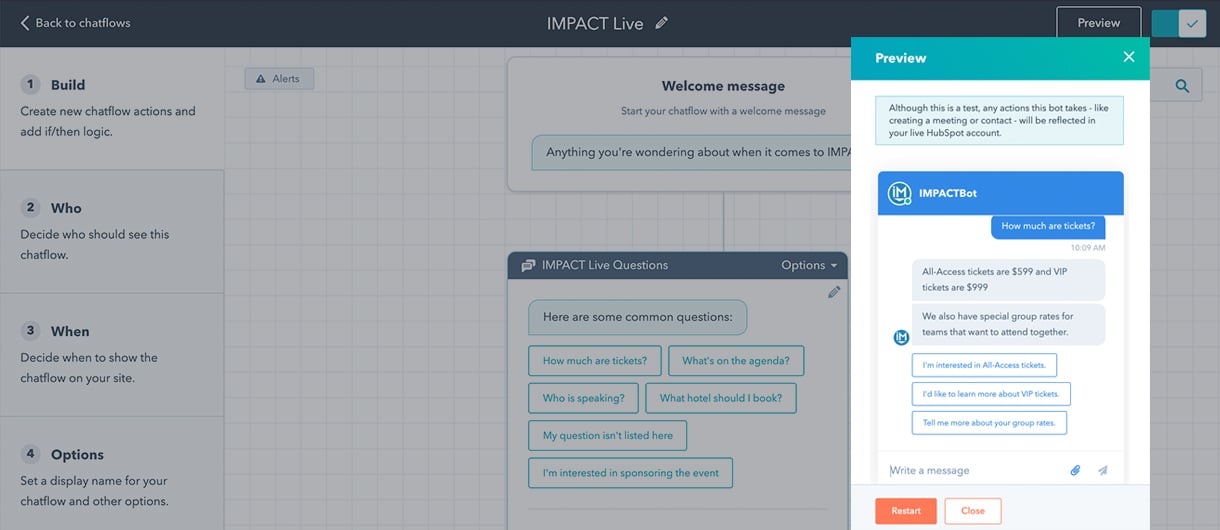How to Choose the Right Automate Marketing Software for Your Business
Are you tired of wasting time on repetitive, tedious marketing tasks? Do you want to free up more time to focus on strategic, high-impact work? If so, marketing automation is the solution you've been looking for. In this article, we'll show you how to choose the right marketing automation software for your business so you can start reaping the benefits of automation and take your marketing to the next level.
Marketing automation is like a GPS for your marketing journey. It helps you navigate the course and reach your destination more efficiently. It does this by using software and technology to automate repetitive, time-consuming marketing tasks such as email campaigns, social media posting, and lead nurturing.
As a business owner, sales manager, or marketer you know that time is a precious resource. You have a lot on your plate, and you need to do more with less. Marketing automation can help you do just that by streamlining your marketing processes and freeing up your time to focus on more important tasks.
But with so many marketing automation software options out there how do you choose the right one for your business? That's what we'll be covering in this article. We'll give you an overview of the different types of marketing automation software available and provide tips on how to evaluate and compare them to find the one that best fits your needs.
Identify Your Business Goals

In the same way that a GPS helps you map out the best route to your destination, marketing automation can help you achieve specific business goals. But before you can choose the right marketing automation software, you need to know what you want to achieve.
To determine what you want to achieve with marketing automation, it's important to first evaluate your current marketing strategy and how automation can support it. Consider what tasks are taking up the most time and resources and how automation can help streamline those processes.
Once you have a clear understanding of your current marketing strategy and how automation can support it, it's time to set specific, measurable, attainable, relevant and time-bound (SMART) goals for your marketing automation efforts. Some examples of SMART goals for marketing automation might include:
-
Increase website traffic by 25% in the next quarter through automated email campaigns and social media posting
-
Reduce lead response time by 50% in the next year through automated lead nurturing and sales workflow automation
-
Increase customer retention by 20% in the next year through automated customer onboarding and engagement campaigns
By setting clear, measurable goals, you can better evaluate the effectiveness of your marketing automation efforts and determine which software is the best fit for your business.
Define Your Target Audience

In the same way that a GPS helps you navigate to your destination, marketing automation can help you reach and engage with your target audience more effectively. But before you can choose the right marketing automation software, you need to define your target audience and understand their needs, wants, and preferences.
First, consider who your ideal customers are and what their customer journey map looks like. Who are they, and what are their main points and goals? How do they typically research and make purchasing decisions? Understanding your audience's needs and preferences will help you tailor your marketing efforts and choose the right marketing automation tools.
Next, consider how marketing automation can help you reach and engage with your target audience more effectively. For example, if your audience is primarily young professionals, you might consider using marketing automation to automate social media postings or send targeted email campaigns. If your audience is more traditional, you might consider using marketing automation to send direct mail or automate lead nurturing efforts.
By defining your target audience and understanding their needs and preferences, you can better evaluate which marketing automation tools will be most effective in reaching and engaging them.
Consider Your Budget
Once you've identified your business goals and defined your target audience, it's important to consider your budget when choosing marketing automation software. Marketing automation can be a significant investment, so it's important to determine how much you are willing and able to spend upfront.
When researching pricing and pricing models for different software options, consider the features and capabilities that are most important to your business. Some software options may have more advanced features but may also come with a higher price tag. Determine what features and capabilities are most important to your business and prioritise accordingly.
It's also important to consider the long-term costs of marketing automation. Some software options may have a lower upfront cost but may charge additional fees for things like support, training, or integrations. Make sure to factor in these long-term costs when evaluating different software options.
By considering your budget and prioritising the features and capabilities that are most important to your business, you can better evaluate which marketing automation software is the best fit for your needs.
Evaluate Software Features and Capabilities
Now that you've identified your business goals, defined your target audience, and considered your budget, it's time to evaluate the features and capabilities of different marketing automation software options.
To do this, it's important to determine which features and capabilities are most important to your business goals and target audience. Do you need advanced email marketing capabilities, or are you more focused on social media automation? Do you need integrations with your CRM or other marketing tools, or are you more concerned with lead nurturing and workflow automation?
Once you've identified the features and capabilities that are most important to your business, it's time to research and compare different software options. Look for software that offers the features and capabilities you need, and consider any integrations or third-party tools that may be necessary for your marketing automation efforts.
By evaluating the features and capabilities of different marketing automation software options, you can better determine which one is the best fit for your needs.
Test and Demo the Marketing Automation Software

Once you've narrowed down your options to a few software options that meet your business goals, target audience, budget, and desired features and capabilities, it's time to test and demo the software to ensure it meets your needs and is easy to use.
To do this, request demos or free trials of the software options you are considering. This will give you the opportunity to test out the features and capabilities of the software and see how it fits into your marketing workflow.
It's important to involve key stakeholders in the testing process, such as marketing and sales team members, to gather feedback and ensure that the software meets the needs of all relevant departments.
Keep in mind that Crocodile Marketing is a HubSpot certified partner, and we offer free demos of HubSpot's marketing automation software. If you're interested in learning more about how HubSpot can support your marketing efforts, don't hesitate to reach out to us for a demo.
By testing and demoing the software, you can make a more informed decision about which marketing automation software is the best fit for your business.
Review Customer Support and Training Options
Once you've tested and demoed the software options you're considering, it's important to review the customer support and training options available from each provider. Marketing automation can be a complex tool, and it's important to have access to the support and training you need to get the most out of your investment.
To determine what level of support and training you will need, consider the size and experience level of your marketing team as well as your overall goals and objectives. Do you need comprehensive training to get up to speed on the software, or do you have a more experienced team that just needs occasional support?
Once you have a clear understanding of your support and training needs, research and compare the options available from different software providers. Some software options may offer more comprehensive training and support, while others may have more limited options. Consider any additional resources or training you may need to fully use the software and factor these costs into your decision.
By reviewing the customer support and training options available from different software providers, you can better determine which one is the best fit for your business.
Consider Scalability and Growth Potential

In the same way a GPS helps you navigate to your destination and plan for future trips, it's important to consider the scalability and growth potential of your marketing automation software. You want to choose a software option that can grow with your business and support your long-term marketing goals.
The best marketing automation software for you
To determine whether the marketing automation software can grow with your business, consider whether it has the necessary capabilities to support your long-term marketing goals. Do you envision expanding your marketing efforts to include new channels or tactics in the future? If so, you'll want to choose a software option that can accommodate these changes.
It's also important to research the software provider's track record of updates and new features. Look for a provider that is actively developing and improving their software, and consider whether their roadmap aligns with your long-term marketing goals.
By considering the scalability and growth potential of your marketing automation software, you can ensure that it will support your business as it grows and evolves.
Research the Software Provider's Reputation
In addition to evaluating the features and capabilities of different marketing automation software options, it's important to research the reputation of the software provider. A software provider's reputation can give you insight into the quality of their product, as well as their customer support and training options.
To check the software provider's reputation, you can look for online reviews and ratings as well as consider their history, experience, and industry recognition. Some well-known marketing automation software providers include HubSpot marketing automation, Marketo, Pardot, and Keap (Infusionsoft).
It can also be helpful to research the provider's customer base and case studies to see how the software has been used successfully in other businesses. This can give you a sense of the software's real-world applications and potential for success in your business.
By researching the software provider's reputation, you can make a more informed decision about which marketing automation software is the best fit for your business.
You Can Make a Decision and 
Now that you've gathered all the necessary information, it's time to make a decision about which marketing automation software is the best fit for your business. Use the information you've gathered about your business goals, target audience, budget, desired features and capabilities, customer support and training options, scalability and growth potential, and the software provider's reputation to make an informed decision.
Once you've chosen your marketing automation software, it's time to set it up and configure it according to your specific needs and goals. This may involve importing your existing data, integrating the software with your other marketing tools, and setting up automation workflows.
Finally, it's important to test and optimise the software to ensure it is working effectively. Monitor your results and make any necessary adjustments to your automation workflows to ensure that you are achieving your desired outcomes.
By following these steps, you can successfully implement marketing automation software and take your marketing efforts to the next level.
Integrate with Other Tools and Systems
To fully leverage the power of marketing automation, you may need to integrate your marketing automation software with other tools and systems. This could include your CRM, email marketing platform, social media tools, or other marketing tools you use on a regular basis.
To determine which other tools and systems will need to be integrated with your marketing automation software, consider your overall marketing workflow and the tools you use at each stage. For example, you may want to integrate your CRM with your marketing automation software to track and nurture leads more effectively.
Once you've identified the tools and systems you'll need to integrate with your marketing automation software, research and compare the integration options and capabilities of different software options. Some software options may offer more comprehensive integration options, while others may have more limited capabilities.
Once you've chosen your marketing automation software, it's important to set up and test any necessary integrations to ensure that everything is working smoothly.
If you're looking for more guidance on how to integrate your marketing automation software with other tools and systems, don't forget to download our guide "HubSpot Integration: How to save time and grow your business". It's full of valuable tips and best practices for getting the most out of your marketing automation software.
Set Up and Optimise Workflows

Once you've chosen your marketing automation software and set up any necessary integrations, it's time to set up and optimise your workflows. Marketing automation software allows you to automate repetitive, time-consuming marketing tasks, such as email campaigns, social media posting, and lead nurturing.
To get started, determine which workflows and processes can be automated with your marketing automation software. This may involve setting up automated email campaigns, social media posting, or lead nurturing workflows.
Once you've set up your automated workflows, it's important to test them to ensure they are working effectively. This may involve monitoring your results and making any necessary adjustments to your automation settings.
As you continue to use your marketing automation software, it's important to regularly optimise your workflows to improve efficiency and effectiveness. This may involve adjusting your automation settings, testing different approaches, or adding new workflows as needed.
By setting up and optimising your workflows, you can fully leverage the power of marketing automation to streamline your marketing efforts and achieve your desired outcomes.
Set Up and Configure Tracking and Reporting
To fully understand the impact of your marketing automation efforts and make informed decisions about your marketing strategy, it's important to set up and configure tracking and reporting within your marketing automation software.
To get started, determine what tracking and reporting capabilities are important for your business goals and target audience. Do you need to track website traffic and conversions, or are you more focused on email open and click-through rates? Understanding what data is most important to your business will help you choose the right marketing automation software and configure your tracking and reporting settings.
Once you've determined what tracking and reporting capabilities are important to your business, set up and configure tracking and reporting within your marketing automation software. This may involve setting up tracking pixels, integrating with Google Analytics, or configuring custom reports.
It's also important to determine how you will use tracking and reporting data to optimise your marketing efforts. Regularly review your tracking and reporting data to identify trends and areas for improvement, and use this data to inform your marketing strategy.
By setting up and configuring tracking and reporting within your marketing automation software, you can gain valuable insights into the effectiveness of your marketing efforts and optimise your strategy for success.
Develop and Implement a Marketing Automation Strategy

Now that you've chosen your marketing automation software and set it up, it's time to develop and implement a marketing automation strategy. This will help you determine how marketing automation will fit into your overall marketing strategy, and how you will use the software to achieve your marketing goals.
To develop a marketing automation strategy, consider your overall marketing goals and objectives, as well as your target audience and key performance indicators (KPIs). Determine how marketing automation can support your efforts to reach and engage with your target audience, and set specific, measurable, attainable, relevant, and time-bound (SMART) goals for your marketing automation efforts.
Once you've developed a plan for how you will use marketing automation to achieve your marketing goals, it's time to implement the strategy. This may involve setting up automated email campaigns, social media posting, or lead nurturing workflows, as well as integrating the software with your other marketing tools.
As you implement your marketing automation strategy, be sure to track progress against your goals. Regularly review your tracking and reporting data to see how your marketing automation efforts are performing, and make any necessary adjustments to your strategy as needed.
By developing and implementing a marketing automation strategy, you can leverage the power of the software to streamline your marketing efforts and achieve your desired outcomes.
Train Your Team on the Software
For any organisation, training team members on new software can be a challenge. Determining which team members will be using the marketing automation software and what level of training they will need is a key part of the process. With marketing automation software, it's important to have some team members who are power users and others who are more casual users in order to get the most out of the tool.
When it comes to providing training resources or materials, many software providers offer extensive tutorials within their platform. They often include step-by-step guides and videos demonstrating how to use each feature. Additionally, there may be webinars, live events, and other educational materials available to help you learn more about the platform and ensure your team is prepared for success with their marketing automation efforts.
If you don't feel comfortable relying solely on self-paced learning methods, consider hiring a consultant or third-party trainer to provide additional training and support. These professionals have experience working with different types of marketing automation tools and can help you get up and running faster. They can also provide guidance in setting up campaigns and automations, as well as best practices for optimising your processes for maximum efficiency.
Make sure that you give your team enough time to practise with the software before putting it into production use. Establishing clear objectives for each individual role can help everyone understand how best to leverage the platform for daily tasks – this way everyone knows what their responsibilities are when it comes time to put their new skills into action!
Develop and Implement a Marketing Automation Strategy

When developing your marketing automation plan, it's important to consider how it will fit into your overall marketing strategy. The goals that you have set need to be taken into account, as well as the messages that are being sent out and the systems that need to be integrated in order to achieve those goals.
Once you have identified how marketing automation will fit into your overall marketing strategy, it is time to develop a plan for how you will use the software to achieve your marketing goals. This involves deciding which automated functions are most important to you, such as email campaigns, social media posts or other activities that can help move prospects through the sales funnel. It also includes determining who will manage each automated function – internally or externally – choosing which automated platforms best meet the needs of your organisation, and setting up processes for testing and optimising these activities over time.
The next step is implementation of the marketing automation strategy. Your plan should include tasks like setting up automated workflows, integrating needed software tools, segmenting contacts according to their interests or position in the buyer’s journey, creating/sending automated emails based on triggers such as actions taken by prospects or opt-in date, automating social media posts across multiple channels (Facebook, Twitter, etc.), tracking performance via analytics or reporting tools (such as Google Analytics).
Finally, once everything is set up correctly, it’s important to track progress against your goals so that you can measure success. Ensure that you are regularly assessing the data from your campaigns in order to analyse what works best so that you can adjust your strategies accordingly. This could involve evaluating email open rates; click-through rates; engagement levels; website visits; conversion rates; lead scores; customer referrals etc., in order to make sure your efforts are paying off with successful outcomes for your business.
Monitor and Optimise Your Marketing Automation Efforts
It's important to keep track of your marketing automation efforts to ensure that you are maximising their effectiveness. Regularly review and analyse tracking and reporting data to optimise your marketing automation efforts, and make necessary adjustments as needed. Keeping a close eye on the effectiveness of your workflows, processes, campaigns, and other elements is key for success.
To get the most out of your marketing automation software, it’s also important to stay up-to-date on its features and capabilities. New features can open up new possibilities for automating parts of your marketing strategy that previously may have been too time consuming or costly to achieve. You should consider how each new feature could help grow your business or reduce operational costs.
For example, some platforms offer machine learning-based functionality that can learn from customer behaviours over time, so you don't have to manually configure certain automated processes. Each platform offers different features, so be sure to explore more advanced options once you get the basics down.
Additionally, some software comes with built-in analytics functions that allow you to measure performance metrics more accurately and efficiently than ever before. This includes things like tracking click through rates (CTRs) on emails or measuring ROI on campaigns; this data is key for making informed decisions about future activities.
It’s also important to monitor changes in customer behaviour or preferences over time so you can adjust any automated processes accordingly if necessary. This could include refining existing segments or creating new ones in order to better target potential customers or sending specific messages at different points in the sales cycle depending on past impressions—all of which help maximise overall efficiency while ensuring relevant content is being sent at the right time.
In summary, keeping an eye on both traditional analytics, as well as changes in customer behaviour, will help ensure you're using your marketing automation platform as effectively as possible. Make sure you regularly review both tracking and reporting data and keep an eye out for brand new features and capabilities offered by the platform in order to maximise efficiency while staying up-to-date with industry trends. By doing this, you are sure to get the most out of your investment into marketing automation technology!
Measure and Report on the ROI of Your Marketing Automation

Understanding the return on investment (ROI) of your marketing automation efforts is critical. It is important to be able to measure and report accurately on your ROI in order to identify areas of improvement and continue to optimise your marketing automation strategy.
In order to track the ROI of your marketing automation efforts, it is necessary to collect relevant data. This includes setting up tracking tools such as Google Analytics or a CRM system for lead data capture (we use and recommend HubSpot CRM). Once collected, it is important to analyse this data in an effort to best understand what works and what does not work in terms of driving ROI from campaigns. Depending upon the complexity of campaigns being run, there could also be other aspects that need monitoring, such as customer lifetime value or customer journey analysis, once they have been converted into customers.
Using this data, it is possible to optimise your marketing automation strategy and improve ROI over time by making adjustments based upon insights gathered from the analysis process. This could mean changing tactics such as customer segments targeted or channels used for communication, or adjusting budget allocations between different campaigns depending upon results achieved. Additionally, reviewing results regularly allows businesses to recognise opportunities quickly, so that action can be taken more rapidly than if left unchecked until much later down the line when potentially a lot more money has been spent without a result.
By taking the time upfront when beginning a new marketing automation effort to determine which metrics will be tracked and monitored along with setting up systems needed for capturing this information, businesses can increase their chances of success greatly by identifying areas for improvement early on before too much money has been invested into a failing project. In short, tracking, measuring and reporting on the ROI from all marketing automation campaigns provide vital insights into where investments should be made in order to drive greater returns while also providing feedback needed for continual optimisation over time.
Tips for Successful Marketing Automation tools

If you want to achieve success with your marketing automation efforts, it’s important that you set clear goals and objectives from the outset. This will ensure that your campaigns are laser-focussed and help you to measure their effectiveness more accurately.
When setting goals for your marketing automation strategy, try to be specific about the desired outcome. For example, if you want to increase website traffic or lead generation, set a target number or percentage of visitors or leads that you would like to achieve over a certain time period. Having clear goals in place will also help you track the ROI of your efforts more easily.
Once you have established what it is that you’d like to achieve, segmenting your audience should be the next step. Segmenting your audience allows you to tailor your communications in order to deliver more personalised and targeted messages, which will help improve customer engagement and conversion rates. By segmenting based on behavioural or demographic data such as age, gender or location, for example, you can create multiple customer personas and further refine your targeting by sending relevant content at the right time.
Testing and optimising is essential when it comes to achieving successful results from marketing automation campaigns. Testing different messages and creative elements such as images or calls-to-action (CTAs) will help identify what works best with each customer segment – this could be anything from subject lines for emails through to placement of CTAs on web pages. Regular testing and optimisation of campaigns also ensures that any changes made are constantly monitored, so that any unexpected results can be quickly addressed and rectified as necessary
Marketing automation should not be seen as an isolated tool but rather integrated with other marketing activities such as SEO, PPC, email marketing etc., in order to maximise its potential. For example, a strong SEO strategy is essential in order for automated campaigns to reach their intended audiences at the right time; similarly social media can be used within a marketing automation campaign via automated posts triggered by certain actions taken by customers or prospects on a website or landing page – this helps ensure that they are receiving timely offers tailored specifically according their interests or behaviour.
Finally, it’s important to keep an open mind when it comes to implementing a successful marketing automation strategy – especially since needs and goals change over time; therefore, having an agile approach is key in order not only to stay ahead of trends but also to remain competitive against rivals who may already have taken advantage of evolving online technologies such as AI / ML etc., one example being AI chatbots which allow conversations between buyers/sellers without human intervention, thereby radically changing the way traditional sales models work today! In addition, customers now expect businesses not only to respond quickly but also to proactively address their enquiries via automated methods – which further highlights why businesses need to look at investing in new technologies in order ensure long-term success within increasingly competitive markets!
Conclusion
As busy professionals, you are often limited in time and need to do more with less. Automating your marketing activities can help them save time, increase productivity, and achieve better results.
When choosing a marketing automation tool for your business needs, it is important for you to assess what features are most important for you as well as how much you are willing to invest in automation tools. You can do this by comparing different products available on the market before making an informed decision about which product will best suit your needs.
Ultimately, by considering marketing automation solutions for your business needs and taking the proper steps towards choosing the right one for your business requirements, you can significantly reduce costs associated with manual tasks while improving both efficiency and effectiveness when it comes to lead generation efforts.
Our team at Crocodile Marketing can provide further guidance on this topic and help you get started with finding the right solution for your business – contact us today!





